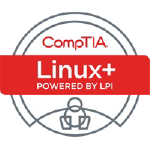

 CompTIA Linux+ Certification (Exam XK0-005)
CompTIA Linux+ Certification (Exam XK0-005)
Course Length:
1 Week 5 Days, 8 hours/day, from: 9:00 am to 5:00 pm
2 Weeks, 3 Hours/day, from 6:00 pm to 9:00 pm
CompTIA Linux+ certification provides a foundation for individuals to work and maintain Linux installations. Linux+ certification is valuable for those new to or currently working within the Linux operation system.
In this course, you will configure, operate, and troubleshoot Linux systems.
1 - PERFORMING BASIC LINUX TASKS
Topic A: Identify the History and Development of Linux
Topic B: Enter Shell Commands
Topic C: Get Help Using Linux
2 - MANAGING USERS AND GROUPS
Topic A: Assume Superuser Privileges
Topic B: Create, Modify, and Delete Users
Topic C: Create, Modify, and Delete Groups
Topic D: Query Users and Groups
Topic E: Configure Account Profiles
3 - MANAGING PERMISSIONS AND OWNERSHIP
Topic A: Modify File and Directory Permissions
Topic B: Modify File and Directory Ownership
Topic C: Configure Special Permissions and Attributes
Topic D: Troubleshoot Permissions Issues
4 - MANAGING STORAGE
Topic A: Create Partitions
Topic B: Manage Logical Volumes
Topic C: Mount File Systems
Topic D: Manage File Systems
Topic E: Navigate the Linux Directory Structure
Topic F: Troubleshoot Storage Issues
5 - MANAGING FILES AND DIRECTORIES
Topic A: Create and Edit Text Files
Topic B: Search for Files
Topic C: Perform Operations on Files and Directories
Topic D: Process Text Files
Topic E: Manipulate File Output
6 - MANAGING KERNEL MODULES
Topic A: Explore the Linux Kernel
Topic B: Install and Configure Kernel Modules
Topic C: Monitor Kernel Modules
7 - MANAGING THE LINUX BOOT PROCESS
Topic A: Configure Linux Boot Components
Topic B: Configure GRUB 2
8 - MANAGING SYSTEM COMPONENTS
Topic A: Configure Localization Options
Topic B: Configure GUIs
Topic C: Manage Services
Topic D: Troubleshoot Process Issues
Topic E: Troubleshoot CPU and Memory Issues
9 - MANAGING DEVICES
Topic A: Identify the Types of Linux Devices
Topic B: Configure Devices
Topic C: Monitor Devices
Topic D: Troubleshoot Hardware Issues
10 - MANAGING NETWORKING
Topic A: Identify TCP/IP Fundamentals
Topic B: Identify Linux Server Roles
Topic C: Connect to a Network
Topic D: Configure DHCP and DNS Client Services
Topic E: Configure Cloud and Virtualization Technologies
Topic F: Troubleshoot Networking Issues
11 - MANAGING PACKAGES AND SOFTWARE
Topic A: Identify Package Managers
Topic B: Manage RPM Packages with YUM
Topic C: Manage Debian Packages with APT
Topic D: Configure Repositories
Topic E: Acquire Software
Topic F: Build Software from Source Code
Topic G: Troubleshoot Software Dependency Issues
12 - SECURING LINUX SYSTEMS
Topic A: Implement Cybersecurity Best Practices
Topic B: Implement Identity and Access Management Methods
Topic C: Configure SELinux or AppArmor
Topic D: Configure Firewalls
Topic E: Implement Logging Services
Topic F: Back Up, Restore, and Verify Data
13 - WORKING WITH BASH SCRIPTS
Topic A: Customize the Bash Shell Environment
Topic B: Identify Scripting and Programming Fundamentals
Topic C: Write and Execute a Simple Bash Script
Topic D: Incorporate Control Statements in Bash Scripts
14 - AUTOMATING TASKS
Topic A: Schedule Jobs
Topic B: Implement Version Control Using Git
Topic C: Identify Orchestration Concepts
15 - INSTALLING LINUX
Topic A: Prepare for Linux Installation
Topic B: Perform the Installation

CompTIA A+ certification is an internationally recognized, vendor-neutral certification that many employers consider...
More
CompTIA Linux+ certification provides a foundation for individuals to work and maintain Linux installations...
More
CompTIA Security+ training provides an excellent introduction to the security field and is typically a better...
More